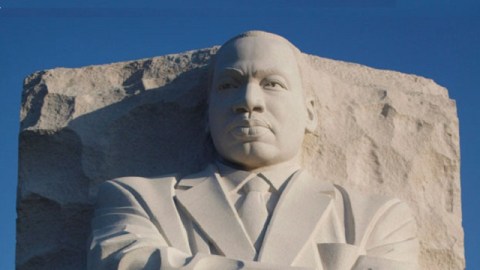The MLK Memorial: Made in China?

The international summer of troubled and/or troubling public art continues and, I hope, concludes with the unveiling of the Martin Luther King, Jr. National Memorial, which was to officially take place in Washington, DC, this Sunday, until Hurricane Irene intervened. Originally scheduled to the mark the 48th anniversary of Dr. Martin Luther King, Jr. “I Have a Dream” speech on the steps of the Lincoln Memorial in 1963, the unveiling already had storm clouds approaching in the form of protestors railing against the use of a Chinese sculptor and Chinese pink granite for the African-American’s tribute. Does it really matter who sculpted the memorial or what it’s made of? Or should a grand symbolic gesture be symbolic through and through?
The memorial takes its main inspiration from a line from that “I Have a Dream” speech. “Out of a mountain of despair,” King prayed, “a stone of hope.” The official website describes the design thus:
“At the entry portal, two stones are parted and a single stone wedge is pushed forward toward the horizon; the missing piece of what was once a single boulder. The smooth insides of the portal contrast the rough outer surfaces of the boulder. Beyond this portal, the stone appears to have been thrust into the plaza, wrested from the boulder and pushed forward – it bears signs of a great monolithic struggle.
“On the visible side of the stone, the theme of hope is presented, with the text from King’s famed 1963 speech cut sharply into the stone: “Out of the mountain of despair a stone of hope.” On the other side are inscribed these words: “I was a drum major for justice, peace and righteousness”, a statement suggested by Dr. King himself when describing how he would like to be remembered.
“The boulder is the Mountain of Despair, through which every visitor will enter, moving through the struggle as Dr. King did during his life, and then be released into the open freedom of the plaza. The solitary stone is the Stone of Hope, from which Dr. King’s image emerges, gazing over the Tidal Basin toward the horizon, seeing a future society of justice and equality for which he encouraged all citizens to strive.”
So, to sum up, you walk through the “Mountain of Despair,” which has been split apart by “a great monolithic struggle” into a “Stone of Hope,” from which MLK’s visage emerges (shown above). I guess the idea that in the Tidal Basin, “justice rolls down like waters and righteousness like a mighty stream,” is implied. The symbolism’s so thick that the address of the memorial is 1964 Independence Avenue to celebrate the 1964 Civil Rights Act, which is a lovely gesture but one seemingly inconsistent with the 1963 “I Have a Dream” speech theme so prevalent everywhere else. I shouldn’t quibble with the memorial designers. Memorials are all about creating memory through evocative symbolism—heavy, pervasive, and obvious even to the children learning about MLK and Civil Rights for the first time.
But how is it possible to compose such a grand symphony of symbolism and yet be tone deaf at the same time? The biggest wrong note in question is Chinese Master Sculptor Lei Yixin. Lei’s previous experience in creating public art came in his native land in sculpting memorials to Mao Zedong, among others. I doubt Mao and Martin would ever share a beer together, let alone an artist. In April 2008 the U.S. Commission of Fine Art actually rejected Lei’s earlier design as too confrontational. Just judging from the photos, it does seem that King with crossed arms is more warrior than peace-maker, although he was a warrior for peace. I may be influenced by knowing Lei’s history, but I can’t help but shake the idea that you could rip off the MLK mask and find Mao scowling beneath. How hard would it have been for the organizers to find a suitable African-American sculptor? Some critics allege that such a search never happened, which would be a shame. I’m not saying that it had to be an African-American. But if you’re going to get all “Mountain of Despair” and “Stone of Hope,” why not take the extra, but extra-important, step of making the choice of a sculptor enjoying the fruits of MLK’s labor today? The fact that the sculpture itself is made of Chinese pink granite (chosen to stand out from the other memorials in DC made of American stone) is just more bitter icing on the cake, especially for an American granite industry already competing with Chinese and other foreign markets.
In just this past year, Oliviero Rainaldi’s quirky statue of Pope John Paul IIdrew the ire of Italians, some of whom thought it looked more like Italian fascist dictator Benito Mussolini; while in Chicago, Seward Johnson’s skirt-flying Forever Marilyn made some look up (her skirt) and others look away. Now Lei Yixin’s MLK via Mao completes the summer’s triumvirate of taste-challenging public sculpture around the globe. I guess the lesson for future planners of grand public sculpture is that if you’re going to go symbolic, take the advice of Marilyn Monroe in a different field, and go all the way.





